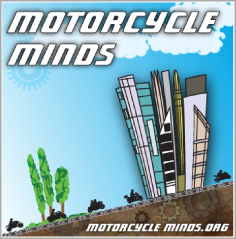 Right To Ride has the latest news on the EU motorcycle proposal (aka Approval and market surveillance of 2 or 3 wheel vehicles and quadricycles) from Brussels as of today, 5 p.m. Friday 8th June.
Right To Ride has the latest news on the EU motorcycle proposal (aka Approval and market surveillance of 2 or 3 wheel vehicles and quadricycles) from Brussels as of today, 5 p.m. Friday 8th June.
Yesterday the IMCO Committee (Internal Market and Consumer Protection Committee), Council and Commission met to discuss the EU motorcycle proposal.
Note that these discussions aka informal trialogues are still ongoing and until the fat lady sings (until the Council adopts and parliament vote confirms), nothing is cast in stone, and in these negotiations nothing is agreed until everything is agreed, so the situation remains fluid.
However, they talked a lot and worked out further compromises which we think are working towards a solution that will be acceptable even for the most sceptical.
ABS (Advanced Braking Systems)
It is fairly clear that L3e category motorcycles (A2/A3 only) will have to have mandatory ABS (Anti-Lock Braking System) (and supplemental CBS (Combined Braking System) if the manufacturer wishes) two years after the adoption date.
However, if the manufacturer wishes, this category can have a switch to turn the system off.
The emerging rules may include that the L3e A1 category (which is the low performance motorcycle e.g. below 125cc) would be differentiated:
- between new models/types which will have to have mandatory ABS/CBS (barring compatibility issues) two years after the adoption date.
- Existing models/types which will only have to have mandatory ABS/CBS seven years after the adoption date.
There is still nothing to stop manufacturers fitting ABS off switches for this category either.
Alternatively, the introduction of mandatory ABS/CBS in the A1 category may be subject to a review clause calling for a feasibility study to establish whether ABS systems below 125cc is cost effective for this category.
Alternatively and furthermore, the Council could reject mandatory ABS below 125cc outright.
However there may need to be further clarification regarding the ABS timetable which would be that according to formal discussions so far, the date 2014+2 years after adoption date = 2016 for new Type Approvals and 2017 for existing Type Approvals.
Also as regards A1: what is meant by ABS/CBS? Does this mean that either ABS or CBS can be fitted at the choice of the manufacturer?
Unlike the L3e category motorcycles (A2/A3 which will have to have mandatory ABS (Anti-Lock Braking System) (and supplemental CBS (Combined Braking System) if the manufacturer wishes.
The logical step for the A1 would be if the requirement were to fit ABS full stop, or ABS (and supplemental CBS if the manufacturer wishes).
Anti-tampering or Article 18
Please note that anti-tampering does not mean anti-modification!
As previously reported, article 18a is Kaputt!
Discussions are now moving towards the possibility of excluding L3e/A2.
The Council wants it left out and we understand that the Council and Commission work well together, so there is a good chance that anti-tampering measures for this category will not happen.
What that means is that the anti-tampering measures will most probably focus on low performance bikes and mopeds.
OBD ( On Board Diagnostics)
Mopeds will not have to have On Board Diagnostics (that’s OBD I).
The Council wants OBDII to be subject to the results of an environmental study – and that will take a long time to do.
What this means is that OBDII may not become part of the regulation.
Time table
All parties are still trying to find a compromise on the implementation schedule for the emissions stages and individual implementing measures.
The IMCO negotiating team has come up with a rationalised proposal with two clear stages which manufacturers can probably support.
Member States now need to be convinced.
Motorcycle Categories As Set Out In the Commission’s Proposal
Page 22 of the full Regulation as related to categories in this article.
The term ‘L-category vehicles’ covers a wide range of different vehicle types with two, three or four wheels, e.g. two- and three-wheel mopeds, two- and three-wheel motorcycles and motorcycles with side-cars. Examples of four-wheel vehicles, also referred to as quadricycles, are quads and mini-cars.
Article 4 – Vehicle categories
1. L-category vehicles comprise powered two-, three- and four-wheel vehicles as categorised in the following paragraphs and Annex I, including powered cycles, two and three-wheel mopeds, two- and three-wheel motorcycles, motorcycles with sidecars, light and heavy on-road quads, and light and heavy mini-cars.
2. For the purposes of this Regulation, the following vehicle categories and subcategories apply, as described in Annex I:
(a) Category L1e vehicle (light two-wheel powered vehicle), sub-categorised into:
(i) L1Ae vehicle (powered cycle);
(ii) L1Be vehicle (two-wheel moped).
(b) Category L2e vehicle (three-wheel moped).
(c) Category L3e vehicle (two-wheel motorcycle), sub-categorised by:
(i) motorcycle performance, further sub-categorised into:
– A1 vehicle (low-performance motorcycle);
– A2 vehicle (medium-performance motorcycle);
– A3 vehicle (high-performance motorcycle).(ii) maximum designed vehicle speed:
– lower than or equal to 130 km/h;
– higher than 130 km/h.(d) Category L4e vehicle (two-wheel motorcycle with side-car).
.


Speak Your Mind